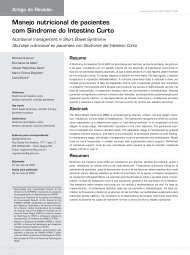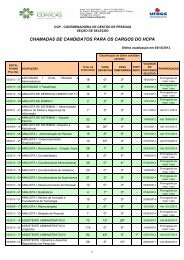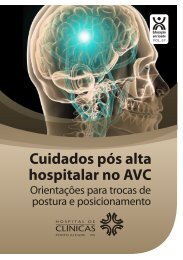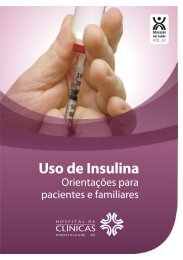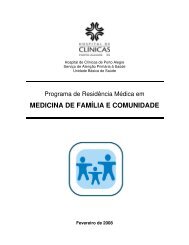Anais da 27º Semana CientÃfica - Hospital de ClÃnicas de Porto Alegre
Anais da 27º Semana CientÃfica - Hospital de ClÃnicas de Porto Alegre
Anais da 27º Semana CientÃfica - Hospital de ClÃnicas de Porto Alegre
You also want an ePaper? Increase the reach of your titles
YUMPU automatically turns print PDFs into web optimized ePapers that Google loves.
172<br />
Revista HCPA 2007; 27 (Supl.1)<br />
good indicator of bad prognosis in invasive breast cancer. Then, cerbB2 status <strong>de</strong>termination could help in the i<strong>de</strong>ntification of the<br />
i<strong>de</strong>al method for stratifying patients with breast cancer into prognostic and optimal therapeutic groups.<br />
POST MENOPAUSE AND BREAST CANCER PROGNOSIS MARKERS<br />
RENATA BRUTTI BERNI; CLAUDIO GALLEANO ZETTLER; VIRGÍNIA RIBAS; RAFAEL DA ROSS MOTTA;<br />
EDUARDO CAMBRUZZI<br />
Introdution: Many studies support that post -menopausal women have shown a better prognosis in breast cancer, expressing more<br />
frequently the estrogen receptor (ER) compared to younger ones. The present study intend to <strong>de</strong>termine if this statement occurs in<br />
our institution, and if the patients' age has any influence on the result of needle biopsies correlated to surgery. Matherial/Methods:<br />
Ninety needle biopsies of breast cancer patients performed at outpatient gynaecology-oncology clinic of Santa Rita <strong>Hospital</strong>,<br />
<strong>Porto</strong> <strong>Alegre</strong>, RS were analised. This study was based on immunohistochemistry method though avidine biotin peroxi<strong>da</strong>se<br />
complex, using estrogen receptor (ER) marker. The <strong>da</strong>ta from the needle biopsy using markers were correlated to patients age and<br />
to surgery. Results: Among 63 post-menopausal patients, 48 (76,1%) presented positive ER for both biopsy and tumor. Otherwise,<br />
among the pre-menopausal ones, only 15 (55%) had this kind of result. The correlation between ER results for biopsy and tumor<br />
was straight, and was not affect by patients age. Conclusion: Post-menopausal patients show higher positivity for ER than the<br />
younger ones, a true statement in our casuistic, and patient's age doesn't influence the biopsy/surgery correlation.<br />
RELATIONSHIP BETWEEN TUMOR SIZE AND ESTROGEN RECEPTORS IN NEEDLE BIOPSIES<br />
RENATA BRUTTI BERNI; CLAUDIO GALLEANO ZETTLER; VIRGÍNIA RIBAS; RAFAEL DA ROSS MOTTA;<br />
EDUARDO CAMBRUZZI<br />
Introdution: Core needle biopsy configures an accurate assessment of a breast mass, because the larger core needle usually<br />
removes enough tissue to evaluate abnormal cells. Besi<strong>de</strong>s, it has shown high diagnosis sensibility. But there's still some doubt if<br />
the results of this method <strong>de</strong>pends on the tumors' size. Matherial/Methods: We studied ninety needle biopsies of breast cancer<br />
patients performed at outpatient gynaecology-oncology clinic of Santa Rita <strong>Hospital</strong>, <strong>Porto</strong> <strong>Alegre</strong>, RS. This study was based on<br />
immunohistochemistry method though avidine biotin peroxi<strong>da</strong>se complex, using estrogen receptor (ER) marker. The <strong>da</strong>ta from<br />
the needle biopsy using markers were correlated to surgery. Results: Among the sixty one needle biopsies ER-positive, 70,5%<br />
were pT2, 16,4% were pT3, 9,9% were pT1 and 3,2% were pT4. Among the remaning twenty-nine cases ER-negative, 58,6%<br />
were pT2, 24,2% were pT1 and 17,2% pT3. The results of ER positivity for the entire tumor analisis were exactly the same.<br />
Conclusions: The core biopsy is an accurate method for the evaluation of ER positivity in<strong>de</strong>pen<strong>de</strong>ntly of the tumor' size (p=0,05).<br />
CORRELATION BETWEEN ESTROGEN RECEPTOR AND P53 EXPRESSION IN CORE BIOPSIES AND IN SURGICAL<br />
SPECIMENS<br />
RENATA BRUTTI BERNI; CLAUDIO GALLEANO ZETTLER; VIRGÍNIA RIBAS; RAFAEL DA ROSS MOTTA;<br />
EDUARDO CAMBRUZZI<br />
Introdution: Many factors have been reported to be able to predict the biological behavior and clinical outcome of breast cancer,<br />
including tumor suppressor gene p53 and steroid receptors. The aim of the present study was to <strong>de</strong>termine the possible<br />
in<strong>de</strong>pen<strong>de</strong>nt correlation between estrogen receptor(ER) and p53 expression in core needle biopsies and in surgical specimens.<br />
Matherial/methods: The author studied ninety needle biopsies of breast cancer patients, which were performed at outpatient Santa<br />
Rita’s gynecology-oncology clinic, <strong>Porto</strong> <strong>Alegre</strong>, Rio Gran<strong>de</strong> do Sul. Patients had a media-age of 59,5 years at diagnosis. The<br />
study was based on immunoistochemistry method through avidin biotin peroxi<strong>da</strong>sis (ABC) complex, using the following markers:<br />
estrogen receptor (ER) and p53 protein. The study was performed at FFFCMPA Pathology Department. The needle biopsy <strong>da</strong>ta<br />
using markers was correlated to surgery. Results: Needle aspiration biopsy revealed a 100% sensitivity and specificity for ER. For<br />
p53, the needle biopsies showed a 92,7% sensitivity and 89,7% specificity. Conclusion: The elevated sensitivity and specificity<br />
found revealed the core needle biopsy utility for ER and p53 research in breast cancer.<br />
CERB-B2 STATUS, TUMOR SIZE AND PROGNOSIS<br />
RENATA BRUTTI BERNI; CLAUDIO GALLEANO ZETTLER; RAFAEL DA ROSS MOTTA; EDUARDO CAMBRUZZI<br />
Introdution: Cerb-B2 amplification seems to predict relative resistence to therapy in estrogen-receptor positive women, and is<br />
associated with a more aggressive phenotype. Our study intends to test if cerb-B2 shows a significant association with tumor size.<br />
Matherial/methods: A review of forty cases of breast cancer was ma<strong>de</strong> in our institution between 2003 and 2007. Inclusion criteria<br />
were patients with infiltrating ductal carcinoma in wich imunohistochemical study was performed, including axillar analyses. The<br />
graduation score results (T1, T2,T3 and T4) were crossed with positive or negative cerb B2. Statiscal analyses was performed<br />
using qui-square test. Results: In our study, C-erb B2 did not show any relationship with tumor size (pConclusion: Although size<br />
of ductal carcinoma and cerb B2 positivity are known to be associated with a more aggressive clinical behavior, a larger tumor<br />
didn't show a significant correlation with positive c-erb B2 in our analisis. This result contrasts with previous studies found in our<br />
revision, maybe due the sample size.<br />
IMMUNOHISTOCHEMICAL ANALYSIS OF TISSUE FACTOR EXPRESSION IN HUMAN COLORECTAL CARCINOMA:<br />
CORRELATION WITH ANGIOGENESIS, CLINICOPATHOLOGICAL ASPECTS AND SURVIVAL<br />
ROBERTO GUIDOTTI TONIETTO; VINICIUS DUVAL DA SILVA; LUCIO SARUBI FILMANN; CAMILA JANKE LOPES;<br />
GUSTAVO FRANCO CARVALHAL; MARCELO GARCIA TONETO; HAMILTON PETRY DE SOUZA; FRANCIEL<br />
LINNÉ<br />
Background: It is recognized that there is a potential interaction between malignant cell growth and the coagulation pathway.<br />
Recently, some studies suggested that tissue factor, a primary initiator of coagulation, is expressed in a variety of solid tumors in<br />
association with increased angiogenesis. Design: The immunohistochemical expression of tissue factor and microvascular <strong>de</strong>nsity




